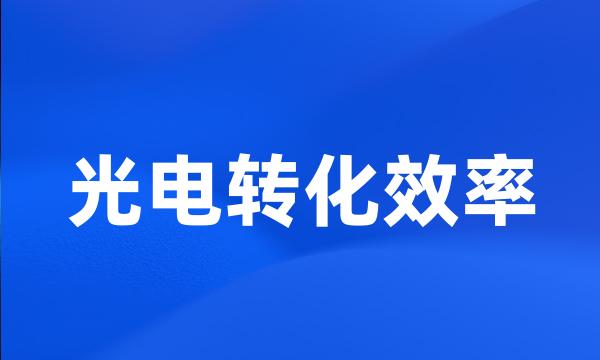光电转化效率
- 网络Photoelectric conversion efficiency;ipce
 光电转化效率
光电转化效率-
DSC光电转化效率受阳极材料,染料,电解液,对电极以及封装工艺等诸多因素的影响。
The photovoltaic efficiency of DSC is affected by anode , electrolyte and cathode .
-
耦合作用扩展了DSSC的光谱响应范围,提高了电池的光电转化效率。
Coupling extended spectral response range and increased the photoelectric conversion efficiency of DSSC .
-
TiO2纳米管的特殊结构,使它具有更大的比表面积和更强的吸附能力,从而表现出更高的光催化性能和光电转化效率。
Because of the special structure of TiO2 nanotube , it has more surface area and stronger adsorptive capacity than other nanotubes , thus , TiO2 nanotubes displays the higher photochemical catalysis performance and the electro-optic transfer efficiency .
-
染料敏化太阳能电池(Dye-SensitizedSolarCell,DSC)作为新一代的薄膜电池,由于具有高光电转化效率、低成本、绿色环保及简便的生产过程,因此有望替代传统硅太阳能电池。
As a new type of thin film solar cell , dye-sensitized solar cell ( DSC ) is an alternative to silicon solar cell due to its high photoelectric conversion efficiency , low cost , environmental friendly , and simple manufacture .
-
通过复阻抗分析,以ZnO作阳极的DSSC三相界面电阻很大,因此其光电转化效率较低于TiO2作阳极的DSSC。
As the resistances of three-phase interface in DSSCs with zinc oxide as anode are much larger through impedance analysis , their efficiency is lower than those of the cells with titanium oxide as anode .
-
染料敏化太阳能电池(DSSCs)以其低成本、低污染和较高的光电转化效率吸引了许多化学工作者的研究。
Dye-sensitized solar cells ( DSSCs ) have attracted growing interest among chemical researchers due to its low-cost , low-pollution and high power conversion efficiency .
-
包覆后的大颗粒制备成二氧化钛光阳极的散射层,使DSSCs的光电转化效率从6.2%提高到了7.1%。
The coated large TiO2 powders were used as a scattering layer of DSSCs to increase the energy conversion efficiency from 6.2 % to 7.1 % .
-
DSSC光电转化效率受阳极的制备方法和工艺影响甚大,优化阳极增强光吸收、减少电子复合成为研究的重点。
The efficiency of DSSC is affected by preparing methods and crafts seriously , hence optimizing the anode is an important part of the DSSC to intensify the photon absorbance and decrease charge recombination .
-
铜铟硒(CIS)或铜铟镓硒(CIGS)和硫化镉(CdS)是制造薄膜太阳能电池的非常优良的化合物半导体材料,CIGS太阳能电池有非常高的光电转化效率,目前已经达到19.9%。
Copper indium diselenide ( CIS ) or copper indium gallium diselenide ( CIGS ) and cadmium sulfide ( CdS ) are both promising semiconductor compounds for fabricating thin film solar cells . CIGS solar cells have reached a very high photo-electric conversion efficiency of 19.9 % .
-
这些都严重影响了染料敏化太阳能电池的光电转化效率。
These all affect DSSC photoelectric conversion efficiency seriously .
-
提高薄膜太阳能电池的光电转化效率是薄膜太阳能电池的主要优化目标。
The main optimization goal of thin-film solar cell is increasing photoelectric conversion efficiency of the thin film solar .
-
对于太阳能电池,随着反射不断增大,光电转化效率会急剧下降。
For solar cells ,, with the increasing of reflection , solar cell conversion efficiency will be significantly decreased .
-
为了得到更高的光电转化效率,大量的研究关注于新的光敏染料的设计和合成。
To achieve high solar power conversion efficiency , great research efforts are focused on designing and synthesizing new photosensitizers .
-
只要不断改进“配方”,纳米“夹心”的光电转化效率就能一次次提高。
As long as the continuous improvement " formula " nano " sandwich ", the photoelectric conversion efficiency can improve again .
-
致力于成为全球在日光能电池范畴品质优异、光电转化效率高、贸易竞争能力强的大型专业日光能电池制造商。
We are committed to be large professional solar cell producer with top quality , high conversion efficiency and strong commercial competition .
-
现阶段影响太阳能普及的主要原因是太阳能电池的成本较高而光电转化效率却较低。
At present , the main reasons that impact the popularity of solar energy are high cost but low photoelectric conversion efficiency .
-
光电转化效率定义为电池输出功率与照射到电池表面光功率的比值。
Photoelectric conversion efficiency is defined as the ratio of solar cells ' output power and the optical power irradiation to the cell surface .
-
本文从提高光电转化效率的角度出发,提出利用神经网络来实现光伏发电最大功率点跟踪。
This paper proposes a method of maximum power point tracking based on neural network from the angle of improving the photoelectric conversion efficiency .
-
提高光电转化效率的关键环节之一是降低硅片表面反射率,吸收更多的光以产生电子空穴对。
One of the most important techniques in improve the conversion efficiency is to reduce the surface reflectance to absorb more light energy to generate more electron hole pairs .
-
光伏发电的缺点是光电转化效率低,成本高,并网中存在诸多问题,因此光伏系统中的控制问题是研究的重要内容。
The disadvantage of PV is less efficient , high cost , low stability of the system , so an important research direction is critical control methods of PV systems .
-
光伏发电是解决当今世界环境问题和能源问题的重要途径之一,如何提高光电转化效率始终是太阳能电池研究的核心问题。
Photovoltaic is one of the important methods to tackle with the global energy crisis and the environment pollution . A lot of efforts have been focusing on the enhancement of the efficiency of the photoelectric conversion .
-
在有机光伏材料选择中,尽管聚合物取得了较高的光电转化效率,但是有机小分子材料具有结构单一、重复性好、易于提纯等优势,成为研究的热点。
In the selection of organic photovoltaic materials , despite that polymers achieve high power conversion efficiency , researchers recently focus on small molecular materials for their simple structure , well reproduction , facile purification , and so forth .
-
与传统的无机半导体太阳能电池相比,染料敏化太阳电池对材料和工艺的要求低,成本低廉,光电转化效率高(目前最高已达到13%),因而作为新一代太阳能电池受到人们广泛的关注。
Dye-sensitized solar cells ( DSCs ), as a new generation of solar cells , have attracted significant attentions due to their low cost , simple process and high photoelectric conversion efficiency , compared with traditional inorganic semiconductor solar cells .
-
着重阐述了工业发达国家以及相应大公司在铜铟镓硒薄膜太阳能电池方面最新进展以及发展趋势,特别介绍了一些太阳能电池的实验室样品和组件的最高光电转化效率。
The emphasis is laid on the new advancements and development tendency of the thin film solar cells in developed industrial countries and relevant companies , especially on their highest photoelectric conversion efficiencies of laboratory samples and products of solar cells .
-
在太阳能利用的研究领域中,提高光电/光热转化效率,降低成本,对促进太阳能产业的发展具有深远意义。
In the field of solar energy utilization , improving the conversion efficiency of photovoltaic / thermal and reducing cost have profound significance to promote the development of the solar industry .
-
着重研究不同TiO2镀膜的厚度对染料敏化太阳能电池光电性能影响,包括光电转化效率、开路电压、短路电流、最大功率和填充因子。
The thesis mainly focused on the effect of the different coating thickness of TiO2 on dye-sensitized solar cells performance , including the photoelectric conversion efficiency , open circuit voltage , short circuit current , maximum power and fill factor .
